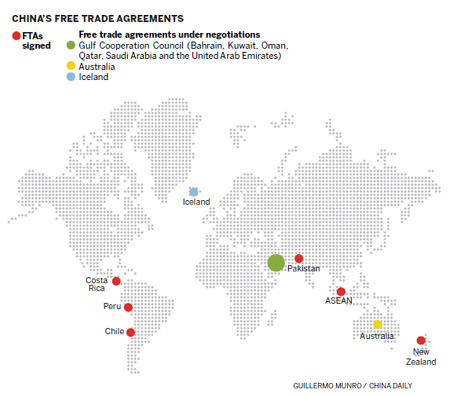WTO entry catalyst for ASEAN FTA
Updated: 2011-12-09 08:38
By Bao Chang (China Daily)
|
|||||||||||
China's admission to the WTO brought forward the establishment of a free trade area (FTA) between China and the Association of Southeast Asian Nations (ASEAN), Xu Ningning, executive secretary-general of the China-ASEAN Business Council, said.
Xu recalled that when he and other Chinese representatives negotiated with ASEAN counterparts about setting up an FTA back in 2001, some Malaysian officials said: "If we cannot defeat you, we will join you."
China and ASEAN signed the Framework Agreement on Comprehensive Economic Cooperation in November 2002 and slashed tariffs substantially on more than 500 kinds of products in 2004. The China and ASEAN Free Trade Area (CAFTA) finally came into effect in January 2010.
Chinese and ASEAN leaders had been working toward this aim while China was trying to join the WTO.
But compared to the arduous journey China undertook to regain its status with the General Agreement on Tariffs and Trade (GATT) and then joining the WTO, Xu said it took a shorter time for China and ASEAN to reach consensus on building an FTA, as ASEAN members realized they would have to meet major challenges in foreign trade from China once the latter joined the WTO.
China also realized that, apart from joining the global community, involvement with regional economic integration was crucial for the sustainable development of the country.
Set up in 1967, ASEAN is made up of Brunei, Cambodia, Indonesia, Laos, Malaysia, Myanmar, the Philippines, Singapore, Thailand and Vietnam, with a total area of 4.44 million square kilometers and a population of 576 million.
In the global market, China and ASEAN share many categories of export. As China becomes more and more open internationally, products from ASEAN will lose their edge in prices and other ways to Chinese exports.
Some foreign enterprises intending to invest in ASEAN markets were also weighing losses and gains in transferring their involvement to the world's most populous country.
"Considering these factors, it was only logical that ASEAN decided to establish an FTA with China," Xu said.
A year after its full implementation, CAFTA has brought mutual benefits. Xu pointed out that the growth of China's imports from ASEAN is much higher than the other way around.
China is currently ASEAN's biggest trading partner and Chinese customs data show that bilateral trade rose by 26.4 percent in the first nine months of 2011 to $267 billion, with an $18.9 billion surplus in favor of ASEAN. From January to September, China's imports from ASEAN surged by 27.9 percent from the same period last year to $143 billion.
At the eighth China-ASEAN Expo, held in October in Nanning, South China's Guangxi Zhuang autonomous region, Premier Wen Jiabao said China is willing to increase its imports from ASEAN.
"CAFTA has increased rather than decreased ASEAN's international competitiveness, and ASEAN's capacity to export to China has become stronger rather than weaker," Wen said.
China and ASEAN have agreed to increase bilateral trade volume to $500 billion by 2015 and China will set up economic and trade cooperation zones with each ASEAN member within the next five years, providing an investment platform for all enterprises.
"CAFTA combines China and ASEAN into a community with mutual interests, and the bloc has been striving to strengthen its influence globally, by such things as pushing forward the Doha Round of trade talks," Xu said.









